Book contents
- Frontmatter
- Contents
- List of Figures
- List of Tables
- Preface
- Acknowledgements
- Linguistic Conventions and Abbreviations
- Abstracts
- Introduction: Frisians – Who, When, Where, Why?
- 1 Palaeogeography and People: Historical Frisians in an archaeological light
- 2 The Anglo-Frisian Question
- 3 Frisian between the Roman and the Early Medieval Periods: Language contact, Celts and Romans
- 4 ‘All quiet on the Western Front?’ The Western Netherlands and the ‘North Sea Culture’ in the Migration Period
- 5 Power and Identity in the Southern North Sea Area: The Migration and Merovingian Periods
- 6 How ‘English’ is the Early Frisian Runic Corpus? The evidence of sounds and forms
- 7 The Geography and Dialects of Old Saxon: River-basin communication networks and the distributional patterns of North Sea Germanic features in Old Saxon
- 8 Between Sievern and Gudendorf: Enclosed sites in the north-western Elbe–Weser triangle and their significance in respect of society, communication and migration during the Roman Iron Age and Migration Period
- 9 Cultural Convergence in a Maritime Context: Language and material culture as parallel phenomena in the early-medieval southern North Sea region
- 10 The Kingdom of East Anglia, Frisia and Continental Connections, c. ad 600–900
- 11 A Comparison of the Injury Tariffs in the Early Kentish and the Frisian Law Codes
- 12 Cultural Contacts between the Western Baltic, the North Sea Region and Scandinavia: Attributing runic finds to runic traditions and corpora of the Early Viking Age
- Index
9 - Cultural Convergence in a Maritime Context: Language and material culture as parallel phenomena in the early-medieval southern North Sea region
Published online by Cambridge University Press: 25 August 2018
- Frontmatter
- Contents
- List of Figures
- List of Tables
- Preface
- Acknowledgements
- Linguistic Conventions and Abbreviations
- Abstracts
- Introduction: Frisians – Who, When, Where, Why?
- 1 Palaeogeography and People: Historical Frisians in an archaeological light
- 2 The Anglo-Frisian Question
- 3 Frisian between the Roman and the Early Medieval Periods: Language contact, Celts and Romans
- 4 ‘All quiet on the Western Front?’ The Western Netherlands and the ‘North Sea Culture’ in the Migration Period
- 5 Power and Identity in the Southern North Sea Area: The Migration and Merovingian Periods
- 6 How ‘English’ is the Early Frisian Runic Corpus? The evidence of sounds and forms
- 7 The Geography and Dialects of Old Saxon: River-basin communication networks and the distributional patterns of North Sea Germanic features in Old Saxon
- 8 Between Sievern and Gudendorf: Enclosed sites in the north-western Elbe–Weser triangle and their significance in respect of society, communication and migration during the Roman Iron Age and Migration Period
- 9 Cultural Convergence in a Maritime Context: Language and material culture as parallel phenomena in the early-medieval southern North Sea region
- 10 The Kingdom of East Anglia, Frisia and Continental Connections, c. ad 600–900
- 11 A Comparison of the Injury Tariffs in the Early Kentish and the Frisian Law Codes
- 12 Cultural Contacts between the Western Baltic, the North Sea Region and Scandinavia: Attributing runic finds to runic traditions and corpora of the Early Viking Age
- Index
Summary
There is little doubt that close links existed between communities on both sides of the southern North Sea in the centuries following the Migration Period. From an archaeological perspective, the numerous sceattas produced in the Low Countries in the late 7th and 8th centuries ad and found in considerable quantities in England are undeniable evidence of this (Metcalf and Op den Velde 2010), as are the technical and stylistic correspondences between high-status dress items such as the ‘royal’ disc-on-bow brooches found in the northern Netherlands and England (e.g. Olsen 2006; Nicolay 2014 and this vol.). These frequent contacts are corroborated by historical evidence, for instance confirming the central position of the ‘Frisians’ in long-distance trade (Lebecq 1983) or the diplomatic interaction between the Warni, an aristocratic group living in the Rhine estuary, and Anglian royalty in the 6th century (Dijkstra 2004, 397; Dijkstra and de Koning, this vol.; Pestell, this vol.).
However, overseas interaction amounted to more than lively diplomatic and economic exchanges; moreover, the archaeological evidence for such interaction is not limited to the core areas of social, economic and political development around the southern North Sea, most notably Friesland, East Anglia and Kent. The present paper approaches this ‘North Sea Culture’ from another perspective. It takes as its main area of study a more peripheral region, coastal Flanders, and considers its relations with both the North Sea region and the hinterland. Furthermore, it focuses on ‘lowly’ categories of material culture belonging to the domestic sphere, far away from the halls of kings and warlords.
Generally speaking, most of the archaeological evidence from the Merovingian Period (ad 500–750) is found in the eastern part of coastal Flanders, an area broadly corresponding to the Carolingian administrative unit of the pagus Flandrensis. Two major landscape-types can be discerned in this region. Along the coast lies the present-day polder area, which prior to the 10th–11th century consisted of an unembanked coastal wetland crossed by tidal channels. By the 7th–8th century, large parts of it were naturally silting up to supra-tidal levels, forming extensive saltmarshes and salt meadows. On its landward side, this area is bounded the Pleistocene cover-sand region.
- Type
- Chapter
- Information
- Frisians and their North Sea NeighboursFrom the Fifth Century to the Viking Age, pp. 173 - 192Publisher: Boydell & BrewerPrint publication year: 2017
- 2
- Cited by



